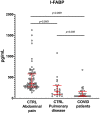I-FABP is decreased in COVID-19 patients, independently of the prognosis
- PMID: 33857216
- PMCID: PMC8049236
- DOI: 10.1371/journal.pone.0249799
I-FABP is decreased in COVID-19 patients, independently of the prognosis
Abstract
Background: Severe acute respiratory syndrome caused by the novel coronavirus (SARS-CoV-2) is frequently associated with gastrointestinal manifestations. Herein we evaluated the interest in measuring the intestinal fatty acid-binding protein (I-FABP), a biomarker of intestinal injury, in COVID-19 patients.
Methods: Serum I-FABP was analyzed in 28 consecutive patients hospitalized for a PCR-confirmed COVID-19, in 24 hospitalized patients with non-COVID-19 pulmonary diseases, and 79 patients admitted to the emergency room for abdominal pain.
Results: I-FABP serum concentrations were significantly lower in patients with COVID-19, as compared to patients with non-COVID-19 pulmonary diseases [70.3 pg/mL (47-167.9) vs. 161.1 pg/mL (88.98-305.2), respectively, p = 0.008]. I-FABP concentrations in these two populations were significantly lower than in patients with abdominal pain without COVID-19 [344.8 pg/mL (268.9-579.6)]. I-FABP was neither associated with severity nor the duration of symptoms. I-FABP was correlated with polymorphonuclear cell counts.
Conclusions: In this pilot study, we observed a low I-FABP concentration in COVID-19 patients either with or without gastrointestinal symptoms, of which the pathophysiological mechanisms and clinical impact remain to be established. Further explorations on a larger cohort of patients will be needed to unravel the molecular mechanism of such observation, including the effects of malabsorption and/or abnormal lipid metabolism.
Conflict of interest statement
The authors have declared that no competing interests exist.
Figures



Similar articles
-
Is I-FABP not only a marker for the detection abdominal injury but also of hemorrhagic shock in severely injured trauma patients?World J Emerg Surg. 2019 Nov 21;14:49. doi: 10.1186/s13017-019-0267-9. eCollection 2019. World J Emerg Surg. 2019. PMID: 31832083 Free PMC article.
-
COVID-19-induced acute renal tubular injury associated with elevation of serum inflammatory cytokine.Clin Exp Nephrol. 2021 Nov;25(11):1240-1246. doi: 10.1007/s10157-021-02101-z. Epub 2021 Jul 10. Clin Exp Nephrol. 2021. PMID: 34245398 Free PMC article.
-
I-FABP is a Novel Marker for the Detection of Intestinal Injury in Severely Injured Trauma Patients.World J Surg. 2017 Dec;41(12):3120-3127. doi: 10.1007/s00268-017-4124-2. World J Surg. 2017. PMID: 28721572
-
Evaluation of circulating insulin-like growth factor-1, heart-type fatty acid-binding protein, and endotrophin levels as prognostic markers of COVID-19 infection severity.Virol J. 2023 May 15;20(1):94. doi: 10.1186/s12985-023-02057-4. Virol J. 2023. PMID: 37189123 Free PMC article.
-
[Intestinal fatty acid-binding protein (I-FABP) as a new biomarker for intestinal diseases].Rinsho Byori. 2010 Feb;58(2):162-8. Rinsho Byori. 2010. PMID: 20229815 Review. Japanese.
Cited by
-
Reduced circulating FABP2 in patients with moderate to severe COVID-19 may indicate enterocyte functional change rather than cell death.Sci Rep. 2022 Nov 5;12(1):18792. doi: 10.1038/s41598-022-23282-x. Sci Rep. 2022. PMID: 36335131 Free PMC article.
-
Transcriptomic and proteomic assessment of tocilizumab response in a randomized controlled trial of patients hospitalized with COVID-19.iScience. 2023 Aug 11;26(9):107597. doi: 10.1016/j.isci.2023.107597. eCollection 2023 Sep 15. iScience. 2023. PMID: 37664617 Free PMC article.
-
Intestinal Fatty Acid Binding Protein (I-FABP) as a Prognostic Marker in Critically Ill COVID-19 Patients.Pathogens. 2022 Dec 13;11(12):1526. doi: 10.3390/pathogens11121526. Pathogens. 2022. PMID: 36558860 Free PMC article.
-
Recognizing a MIS-Chievous Cause of Acute Viral Gastroenteritis.Front Pediatr. 2021 Oct 29;9:748368. doi: 10.3389/fped.2021.748368. eCollection 2021. Front Pediatr. 2021. PMID: 34778138 Free PMC article.
-
Clustering based on renal and inflammatory admission parameters in critically ill patients admitted to the ICU.PLoS One. 2024 Nov 1;19(11):e0307938. doi: 10.1371/journal.pone.0307938. eCollection 2024. PLoS One. 2024. PMID: 39485788 Free PMC article.
References
MeSH terms
Substances
LinkOut - more resources
Full Text Sources
Other Literature Sources
Medical
Research Materials
Miscellaneous

